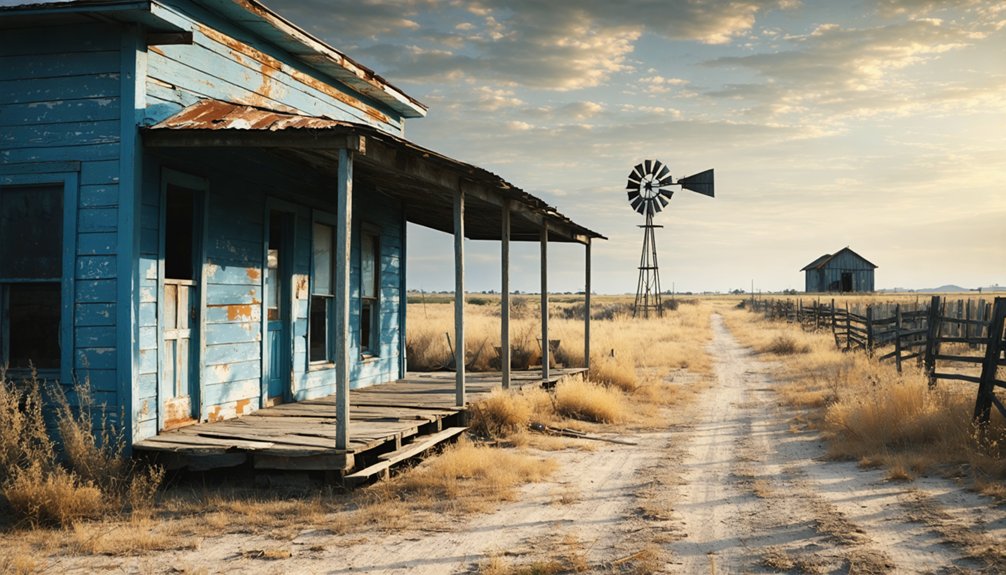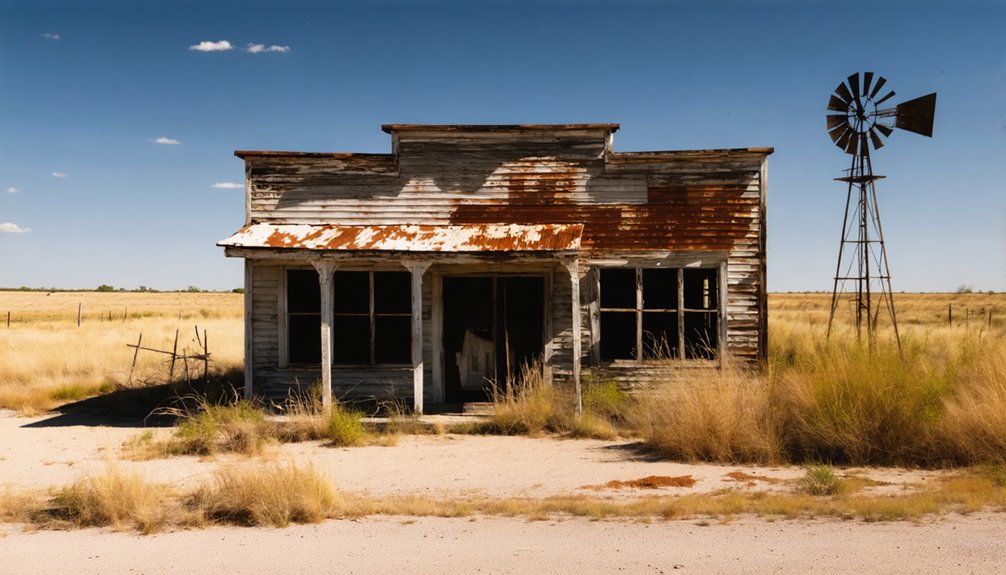You’ll find Farmer, Texas tucked away in Young County, where abandoned buildings tell the story of a once-thriving agricultural community. In the late 1800s, settlers claimed 150-acre plots, establishing cotton farms and ranches alongside essential institutions like churches, schools, and a general store. The town’s fortunes declined after the 1980s farm crisis and oil price collapse. Today, weathered structures and empty streets stand as silent witnesses to a resilient pioneer spirit that shaped early Texas life.
Key Takeaways
- Farmer, Texas was a late 19th-century agricultural settlement that thrived on cotton production before declining due to economic changes.
- The community’s fate was sealed by the lack of promised railroad connectivity, which prevented efficient shipping for local farmers.
- Abandoned wooden structures and empty commercial buildings now mark the ghost town’s location, showing decades of neglect.
- The town’s core institutions included a church, school, and general store that served as social gathering places for the community.
- Local historical societies preserve Farmer’s legacy through photographs, artifacts, and oral histories from former residents and their descendants.
The Rise of an Agricultural Frontier Town
When settlers first arrived in Farmer, Texas in the late 19th century, they discovered fertile land ideal for agricultural development.
You’d find these pioneers claiming 150-acre plots where they cultivated diverse crops including cotton, vegetables, and grains. Like the successful town of Carlton’s cotton production, farming became a major economic driver. The town’s early success hinged on readily available water sources and rich soil conditions that supported varied farming operations.
The arrival of the Chicago, Rock Island and Gulf Railway transformed Farmer’s economic prospects, connecting you to major markets as far as New York City.
Agricultural innovations soon followed, with farmers drilling wells up to 1,000 feet deep to sustain their expanding operations. Similar to Jon Johnson’s experience, families grew tomatoes and onions that were shipped across the country. Despite initial prosperity, these irrigation challenges would later impact the water table, foreshadowing future sustainability concerns.
The establishment of schools, post offices, and local businesses marked Farmer’s evolution into a thriving agrarian community.
Life in Early Farmer: A Community Portrait
Three core institutions anchored daily life in early Farmer: the church, school, and general store.
Like the 511 ghost towns across Texas, Farmer showcased the determination of its early settlers and their quest to build a lasting community.
You’d find these establishments serving as essential hubs where community gatherings strengthened social bonds among the primarily European-descent settlers. The church doubled as both a spiritual center and social venue, while the school balanced children’s education with their farm duties.
Community life revolved around shared spaces where settlers gathered, worshipped, learned and socialized together, forging lasting bonds through common experiences.
Daily routines centered on agricultural practices, with families working together during critical periods like harvest time. Similar to the farmers of Barstow’s farming town, residents faced constant challenges from unpredictable weather and water availability. You’d see neighbors helping neighbors, sharing labor for barn-raising and crop gathering.
Women managed households and preserved food while men worked the fields. The nearby railroad, though not directly serving Farmer, opened trade possibilities for local produce.
Despite these connections, the town’s relative isolation meant residents had to be largely self-sufficient, creating a tight-knit community bound by mutual support.
Cotton Fields and Cattle Ranches
Cotton emerged as Farmer’s primary economic engine in the early 1900s, building upon the town’s agricultural foundation.
You’d find tenant farmers working the fertile soil, often former slaves and Mexican laborers earning about $1.00 per day. During harvest season, entire families would head to the fields with burlap sacks, picking cotton bolls in the scorching Texas heat from August through October. Most families relied on children working alongside adults to maximize their cotton-picking output.
The local cotton gin became the heartbeat of Farmer’s cotton production, processing the harvests before shipping to larger markets. The invention of the cotton gin had revolutionized production in the early 1800s, leading to dramatic expansion of cotton farming across the South.
While cotton dominated the agricultural scene, cattle breeding provided a complementary income stream for many landowners.
As mechanization gradually took hold, you’d see tractors and combines replacing the manual labor that had defined the early years of Farmer’s cotton and cattle operations.
Daily Living in Young County’s Heartland
Since its founding in 1877 by Baptist preacher W.H. Farmer, daily life in this Young County settlement revolved around tight-knit community interactions.
You’d find yourself gathering at the Farmer store, an essential hub where locals exchanged news and supplies. Your daily routines would’ve included vigilant preparation against frontier threats, with Fort Belknap‘s presence offering important protection during uncertain times.
Religious life shaped your social calendar, with Baptist services and church gatherings providing regular opportunities for fellowship. The introduction of barbed wire fencing in 1880 dramatically changed the way residents managed their livestock and property boundaries. For clarity in historical records, the settlement was carefully distinguished as Young County Texas to avoid confusion with other similarly named locations.
Church gatherings and Baptist worship services created vital social bonds, weaving faith and fellowship into the fabric of community life.
You’d join your neighbors at community events, supporting each other through the challenges of frontier life. The Presbyterian church in nearby Eliasville and the Farmer Cemetery served as anchors for your community’s spiritual and cultural heritage.
Multi-generational families formed the backbone of this close-knit society, preserving local traditions and pioneer values.
The Turning Point: Economic Shifts
While the close-knit social fabric of Farmer held strong through its early years, economic forces would dramatically reshape the community’s destiny.
You’ll find that Farmer’s story mirrors many Texas towns that faced the harsh realities of economic dependency on agriculture and oil. As mechanization reduced the need for farm labor and market fluctuations rattled the oil industry, the town’s foundation began to crack.
When the 1980s brought a devastating double blow – the farm crisis and oil price collapse – Farmer couldn’t escape the impact. The loss of essential services followed as residents sought opportunities elsewhere. Similar to many towns that relied on single industry economies, the lack of economic diversity made recovery nearly impossible. The town’s fate echoed that of other communities where rural hospital closures decimated local healthcare services and accelerated population decline.
Like many of its neighbors, Farmer discovered that relying too heavily on a single economic sector left the community vulnerable to forces beyond its control.
Railroad Dreams and Broken Promises
After initial settlers established Farmer with high hopes for agricultural prosperity, the Gulf, Texas and Western Railroad’s decision to bypass the town dealt a crushing blow to its future.
You can trace the railroad’s impact through the economic decline that followed, as neighboring towns with rail access absorbed the commercial activity that might’ve sustained Farmer’s growth.
The bypass reflected a common pattern you’ll find across Texas ghost towns – where railroad routing choices determined a community’s fate. Without rail infrastructure, local farmers couldn’t efficiently ship their produce to distant markets.
The promise of railroad connectivity had encouraged settlement and investment, but when those dreams evaporated, so did Farmer’s prospects.
Like Sherwood and Cedar Mills, Farmer joined the ranks of Texas towns whose destinies were sealed by railroad decisions.
Walking Through What Remains

Today’s visitors to Farmer encounter a landscape shaped by decades of abandonment. As you walk through the deserted landscapes, you’ll find ghostly remnants of a community that once dreamed of railroad prosperity. The harsh Texas environment has taken its toll, with dirt and scrub grass reclaiming much of the terrain.
Time stands frozen in Farmer’s dusty streets, where nature slowly erases the footprints of railroad dreams long forgotten.
You can still explore:
- Weathered wooden structures with boarded windows, showing the telltale signs of long-term neglect
- Derelict commercial buildings that hint at former business activity
- Empty streets where nature steadily erodes what humans left behind
While you’re free to photograph these historic remnants, remember you’re walking on private property. The structural instability of many buildings demands caution as you navigate through this memorial to broken dreams and abandoned ambitions.
Stories From Former Residents
Through the echoes of time, former residents of Farmer, Texas paint a vivid picture of a once-vibrant agricultural community bound by shared struggles and triumphs.
You’ll hear in their nostalgic recollections how local churches and schools formed the heart of their social world, while general stores served as gathering spots where community bonds flourished.
Their stories reveal how weather and market prices shaped daily life, with neighbors helping neighbors through tough times.
You’ll learn of informal bartering systems and shared resources that kept the town alive.
But as machines replaced manual labor and younger generations sought urban opportunities, the town’s liveliness began to fade.
Today, these former residents preserve their heritage through reunions, oral histories, and contributions to local archives, ensuring Farmer’s legacy lives on.
Legacy of a Lost Community

The legacy of Farmer, Texas extends far beyond its abandoned structures and empty streets, embodying a broader narrative of rural American transformation. You’ll find this ghost town’s story deeply woven into the fabric of agricultural decline that reshaped Texas’s countryside during periods of environmental and economic hardship.
- The town’s community resilience shines through preserved oral histories and artifacts, documenting how residents adapted to challenges like water scarcity and shifting market forces.
- Their agricultural heritage lives on through documented farming techniques and infrastructure remains, from cotton gins to grain storage facilities.
- Local historical societies continue collecting photographs and stories, ensuring future generations understand the town’s role in Texas’s rural development.
Today, Farmer stands as a reflection of the determined spirit of early Texas settlers who carved out lives in harsh conditions.
Preserving Farmer’s Place in Texas History
Preserving Farmer’s standing in Texas history has required dedicated efforts from local historians, community organizations, and state heritage associations.
You’ll find historical artifacts carefully preserved in local museums, where collections of photographs, documents, and relics tell the story of this once-thriving community. Annual reunions bring together descendants who share oral histories, enriching the town’s documented legacy.
Through interactive programs and guided tours, you can experience the agricultural lifestyle that shaped Farmer’s identity.
Step back in time to discover authentic farm life through hands-on activities and expert-led explorations of Farmer’s rural heritage.
Community heritage lives on as restoration projects focus on stabilizing original structures and maintaining authentic architectural elements. While legal challenges around property ownership and funding persist, dedicated preservationists continue working to protect the site’s historical integrity through nonprofit initiatives and compliance with conservation guidelines.
Frequently Asked Questions
Are There Any Reported Paranormal Activities or Ghost Sightings in Farmer?
You won’t find documented ghostly encounters or haunted locations here – there are no verified reports of paranormal activity, unlike other Texas ghost towns that have established supernatural reputations.
What Happened to the Cemetery and Burial Records From Farmer?
You’ll find over 430 burial records preserved on Find a Grave, though the cemetery itself lacks maintenance. Cemetery preservation efforts are minimal, with physical markers deteriorating and only partial documentation surviving online.
Did Any Famous or Notorious Individuals Ever Live in Farmer?
While famous residents and local legends often color ghost town histories, you won’t find any notorious figures in Farmer’s past besides Reverend William H. Farmer, the religious leader it’s named after.
Were There Any Major Crimes or Notable Incidents in Farmer’s History?
You’ll find limited documentation of notable incidents in Farmer’s crime history, though nearby areas like Green’s Creek saw murders, including the Papworth strangling that became part of local ghost stories.
Can Visitors Legally Explore the Remaining Structures and Foundations Today?
You can’t legally explore Farmer’s remains without explicit permission since access regulations restrict entry to private property. Follow exploration guidelines by contacting landowners and county offices for authorized visits.
References
- https://www.youtube.com/watch?v=Zd8-gKw-5Hc
- https://livefromthesouthside.com/10-texas-ghost-towns-to-visit/
- https://www.amysatticss.com/ghost-towns/
- https://mix941kmxj.com/route-66-ghost-towns-texas/
- https://en.wikipedia.org/wiki/List_of_ghost_towns_in_Texas
- https://cedarbayoumarina.com/four-ghost-towns-under-lake-texoma/
- https://www.texasescapes.com/TexasTowns/Farmer-Texas.htm
- https://www.tshaonline.org/handbook/entries/farmer-tx-young-county
- https://authentictexas.com/texas-ghost-towns/
- https://www.texasstandard.org/stories/when-lobos-water-dried-up-it-took-the-west-texas-town-with-it/



